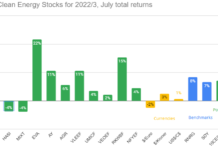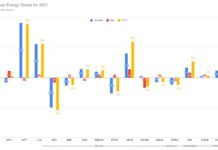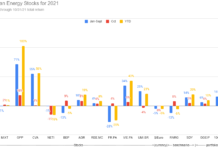Tom Konrad CFA
My Ten Clean Energy Stocks for 2015 model portfolio added a second month to its winning streak, with a 6.1% gain for the month and a 5.7% gain for the year, despite a continued drag by the strong dollar. If measured in terms of the companies’ local currencies, the portfolio would have been up 7.5% for the month and 10.5% for the quarter or year to date. For comparison, the broad universe of US small cap stocks rose 1.5% for the month and 4.0% for quarter, as measured by IWM, the Russell 2000 index ETF.
The six income stocks continue to lead, with a gain of 5.9% for the month and 10.2% for the year. This compares to a miserable performance by my income benchmark of global utility stocks (JXI), which was down 3.1% for the month and 5.5% for the year. The fossil free Green Alpha Global Enhanced Equity Income Portfolio (GAGEEIP), which I co-manage, also outperformed the global utility trend and turned in a 0.6% gain for the month, and 5.3% gain for the year to date.
The four growth and value stocks gained 6.3% for the month, but remain down 1.0% for the year. This compares to their clean energy ETF benchmark (PBW), which rose 1.6% for the month and is up 5.9% for the year.
The chart below (click for larger version) gives details of individual stock performance, followed by a discussion of March news for each stock.
The low and high targets given below are my estimates of the range within which I expected each stock to finish 2015 when I compiled the list at the end of 2014.
Income Stocks
1. Hannon Armstrong Sustainable Infrastructure (NYSE:HASI).
12/31/2014 Price: $14.23. Annual Dividend: $1.04. Beta: 0.81. Low Target: $13.50. High Target: $17.
3/31/2015 Price: $18.28. YTD Dividend: $0.26 YTD Total Return: 30.3%.
The stock of sustainable infrastructure financier and Real Estate Investment Trust Hannon Armstrong continued its impressive advance.
The market price is now above the $17 “High Target” I gave it at the start of the year. That means that it is higher than I expected it to go by the end of 2015, and while I revised my expectation upward when Hannon Armstrong increased their core earnings per share growth target from its previous 12% to 15% range to its current 14% to 16% range, I now feel the company is near its fair valuation. While I am happy to hold the company for its dividend and dividend growth prospects, I have begun trimming my position for rebalancing. It was already my largest holding at the end of 2013; it’s time to bring the stock back in line with the rest of my positions.
Although I am trimming my holdings, I think HASI retains significant upside potential. While I feel it is near its fair valuation now, there is no reason to believe it cannot become overvalued. That has certainly happened with many of the conventional YieldCos: NRG Yield (NYSE:NYLD) and NextEra Enegy Partners (NYSE:NEP), for example. These boast similar growth prospects to HASI, but much lower dividend yields. To bring HASI’s yield down to 4%, which is in the middle of the range for YieldCos today, the stock would have to rise to $26. While I believe many YieldCos are overvalued at current levels, I see no reason why Hannon Armstrong can’t join them.
2. General Cable Corp. (NYSE:BGC)
12/31/2014 Price: $14.90. Annual Dividend: $0.72. Beta: 1.54. Low Target: $10. High Target: $30.
3/31/2015 Price: $17.23. YTD Dividend: $0. YTD Total Return: 15.6%.
International manufacturer of electrical and fiber optic cable, General Cable Corp.’s stock spiked on March 17th based on rumors that it might be bought by larger Italian rival Prysmian (OTC:PRYMF). Prysmian later said in a statement that it had consulted with its advisors about the possibility of buying General Cable or France’s Nexans, but had had no direct discussions with either company. General Cable’s stock held on to most of its gains as investors revalued the company as a possible acquisition target.
3. TransAlta Renewables Inc. (TSX:RNW, OTC:TRSWF)
12/31/2014 Price: C$11.48. Annual Dividend: C$0.77. Low Target: C$10. High Target: C$15.
3/31/2015 Price: C$12.55. YTD Dividend: C$0.19 YTD Total C$ Return: 11.0%. YTD Total US$ Return: 1.6%.
Canadian yieldco TransAlta Renewables, agreed to invest C$1.78 billion in a portfolio of Western Australian assets owned by its parent, TransAlta (NYSE:TAC), with the purchase funded mostly by issuing stock on the public market and to TransAlta at C$2.65 a share. TransAlta will own 76-77% of the yieldco after the transaction closes. TransAlta Renewables will use the increased cash flow per share enabled by the acquisition to increase its monthly dividend to C$0.07 (an increase of 9%) and intends a further 6% to 7% increase after the completion of the South Hedland gas power plant, which is part of the acquisition. After the first dividend increase, the annual dividend will be C$0.84, or 6.7% at the current price.
Although I’m a fan of dividend increases, and think this is a good transaction for current shareholders, the gas pipeline and gas power plant included in the transaction mean TransAlta Renewables will no longer be completely fossil fuel free. That means that all the accounts I manage with Green Alpha Advisors using the Green Alpha Global Enhanced Equity Income Portfolio will need to sell TransAlta Renewables when the deal closes or soon after, which I expect in May. We will be holding on to the stock for the now, however, because I expect the dividend increase should increase the share price once the market absorbs the stock from the secondary offerings.
In fact, I bought the company in some accounts which are managed to a green, but not strictly fossil fuel free, mandate. For my non-fossil fuel free accounts, I consider a company to be green if it would benefit from increased action to combat climate change and other environmental problems. I believe this will still be the case for TransAlta Renewables after the transaction closes. In practice, I tolerate some natural gas assets in managed accounts which are not strictly fossil fuel free as long as they are not large compared to the clean energy assets of the same company.
For readers who do not follow a strict fossil fuel free mandate themselves, I consider the pull-back caused by the secondary offering to be a buying opportunity.
4. Capstone Infrastructure Corp (TSX:CSE. OTC:MCQPF).
12/31/2014 Price: C$3.20. Annual Dividend C$0.30. Low Target: C$3. High Target: C$5.
3/31/2015 Price: C$3.55. YTD Dividend: C$0.075 YTD Total C$ Return: 13.6%. YTD Total US$ Return: 4.0%.
Canadian power producer and developer (yieldco) Capstone Infrastructure lost ground gained in January, and is now down almost 7% in US dollar terms, although all of that decline is due to the weakness of the Canadian dollar. I continue to think that this 9%+ yield company remains one of the best values among clean energy income stocks: it’s high yield and low price are entirely due worries about a very disappointing decision by the regulator of its British water utility subsidiary. Capstone is appealing that ruling, but management has stated that the dividend is not at risk even if the appeal fails. Insiders has put their money where their mouths are by buying the stock on the open market.
In addition to the high yield (which alone seems sufficient reason to own the stock), there is potential for upside if the Bristol Water appeal is successful. Even if this appeal fails, I expect the high yield to cause the stock to appreciate as investors gain confidence that the dividend will not be cut.
5. New Flyer Industries (TSX:NFI, OTC:NFYEF).
12/31/2014 Price: C$13.48. Annual Dividend: C$0.585. Low Target: C$10. High Target: C$20.
3/31/2015 Price: C$14.08. YTD Dividend: C$0.15 YTD Total C$ Return: 5.5%. YTD Total US$ Return: -3.4%.
Leading North American bus manufacturer New Flyer report 2014 fourth quarter and full year results on March 18th. Revenue and Adjusted EBITDA were up for the year, but earnings lagged slightly because of a number of low margin contracts which had been negotiated during the industry downturn. The company is currently focusing on consolidation of its model line after the acquisition of NABI last year. When this consolidation of models is complete, New Flyer will have more free cash flow to return to shareholders or make additional investments. There was some interesting discussion about this at the end of the Q&A part of the conference call. CEO Paul Soubry said:
[W]e continue to look at opportunities where we can acquire and/or invest in new programs. And so we have done that very aggressively and very prudently to look at scenarios that makes sense for us, some inside our space, some adjacent to our space. So as we evaluate some of those scenarios as we look at the leverage of the business, as we execute now on [the consolidation of bus models] for the first part of this year, it’s not out of the realm that we would look at shareholder value enhancement, right now we want to get through this next chapter before make a decision on that. But, we are in a way better place as you know to be able to have that conversation today than we were two years ago than we were six years ago. So that one is a little bit of kind of wait and see for a little bit, but very, very pleased about our ability to have the conversation.
I take this to mean that the board is thinking about dividend increases or share buybacks. Nothing is going to happen until the business consolidation is complete; we could hear more on this in the second half of the year.
Overall, I liked what I heard on the conference call. I wasn’t the only one. New Flyer had its price traget raised by analysts at National Bank and BMO Capital Markets. Canaccord Genuity upgraded the stock to “Buy” from “Hold.”
6. Accell Group (XAMS:ACCEL, OTC:ACGPF).
12/31/2014 Price: €13.60. Annual Dividend: Varies: at least 40% of net profits. €0.55 in 2014. Low Target: €12. High Target: €20.
3/31/2015 Price: €17.31. YTD Dividend: €0. YTD Total € Return: 27.3%. YTD Total US$ Return: 12.9%.
The stock of bicycle manufacturer Accell Group continued to advance, although US investors will not see as much of an increase because of the declining euro, which had its worst quarter against the dollar in the 12 years it has existed. Part of Accell’s appreciation may in fact be due to the declining euro, since the strong dollar may help sales in North America, where Accell has its greatest growth potential. But the rising Euro is mixed news for the Netherlands based bicycle manufacturer, which had to raise prices 5% in its core European market because of higher Euro import prices for components.
Value Stocks
7. Future Fuel Corp. (NYSE:FF)
12/31/2014 Price: $13.02. Annual Dividend: $0.24. Beta 0.36. Low Target: $10. High Target: $20.
3/31/2015 Price: $10.27 YTD Dividend: $0.06. YTD Total Return: -20.7%.
Specialty chemicals and biodiesel producer FutureFuel, has been hit hard over the last few days since it revealed that Proctor & Gamble had given notice that it would terminate its contract with Future Fuel at the end of 2015. FutureFuel makes a bleach activator for P&G: The little blue specks (NOBS) in Tide detergent, which accounted for 13% of 2014 sales.
Sales to P&G have been declining over the last few years because of the overall decline in the market for dry laundry detergents. 2014 sales of NOBS had already declined 27% in 2014 compared to 2013. This announcement is more an acceleration of the existing timeline for FutureFuel to find replacement products than a bolt out of the blue. FutureFuel’s chemical business has a natural churn.
The 18% sell-off in the four days since the termination was announced is far out of proportion to the damage to FutureFuel’s future prospects. Although the current agreement was terminated, the two companies are in talks about a new agreement going forward. It’s likely that FutureFuel will continue to supply some bleach activator to P&G in 2016 and beyond, if at reduced volumes, while it is also likely that FutureFuel will find other products to fill much of the chemical capacity not being used for the bleach activator. I added to my position on the decline.
8. Power REIT (NYSE:PW).
12/31/2014 Price: $8.35. Annual Dividend: $0. Beta: 0.52. Low Target: $5. High Target: $20.
3/31/2015 Price: $8.65. YTD Total Return: 3.6%.
Rail and solar investment trust Power REIT filed its annual report on March 31st. I have not yet had time to review it, but a first glance shows core FFO per share growing to $0.49 in 2014 from $0.41 a year earlier. FFO is a non-GAAP measure of recurring cash flow used by many REITs as a measure of cash available for distribution to shareholders. Net losses, however, were substantial because of litigation costs, property acquisition expenses, and an unrealized loss on an interest rate swap which is part of the financing for one of its solar farms.
As far as I can tell, there was nothing unexpected in the annual report, and the future value of the stock continues to hinge on the outcome if its civil case with its railway lessees.
9. Ameresco, Inc. (NASD:AMRC).
12/31/2014 Price: $7.00. Annual Dividend: $0. Beta: 1.36. Low Target: $6. High Target: $16.
3/31/2015 Price: $7.40. YTD Total Return: 5.7%.
Energy service contractor Ameresco released fourth quarter and full year 2014 results on March 5th. Once again, management was upbeat about the improvement of its industry. To quote from the press release, “We anticipate that our traditional U.S. energy services segments, which have tempered our financial performance the past few years, will experience broad-based revenue growth in 2015.”
The market failed to react to the news, but Obama’s executive order on March 19th for Federal agencies to greatly increase their efforts to reduce Greenhouse Gas emissions seems to have galvanized investors. The stock gained 18% for the month, with almost all of the gain coming after the executive order. Much of Ameresco’s business comes from cost-effectively helping government agencies meet goals like these.
Growth Stock
10. MiX Telematics Limited (NASD:MIXT).
12/31/2014 Price: $6.50. Annual Dividend: $0. Beta: 0.78. Low Target: $5. High Target: $20.
3/31/2015 Price: $6.98. YTD Dividend: $0. YTD Total South African Rand Return: 12.9%. YTD Total US$ Return: 7.4%.
Vehicle and fleet management software-as-a-service provider MiX Telematics turned in a very strong month. I’m not sure what drove the rise other than the extreme undervaluation I discussed in detail last month. Despite the rise, it’s still quite cheap, in my opinion.
There was one interesting news story about how many companies struggle to make use of the data collected by the spread of telematics devices to more vehicles. MiX is a leader in providing the sort of sophisticated solution which helps customers with this problem, and its relatively inexpensive South African software engineers should enable MiX to keep its lead in this area.
Summary
Last month, I used this section to comment that “Capstone Infrastructure and MiX Telematics look particularly attractive at their current prices. Ameresco also looks quite attractive, but its near term performance will hinge on the March 5th earnings announcement and management’s outlook for the rest of the year.”
I was wrong about the reaction to Ameresco’s earnings announcement. It was exactly what I hoped for, but the market was unimpressed. Instead, it took Presidential action to get the stock moving two weeks later. But move it did, and Capstone, MiX, and Ameresco were up 11.6%, 23.5%, and 18.2% for the month in dollar terms, and even more for MiX and Capstone in terms of their local currencies.
I should probably quit while I’m ahead, but this month’s losers, TransAlta Renewables and Future Fuel both look to me like they have fallen too far. I think it would be too much to ask to expect them to do in April what the three stocks above did in March. That said, these two are the stocks I’m buying now.
Disclosure: Long HASI, CSE/MCQPF, ACCEL/ACGPF, NFI/NFYEF, AMRC, MIXT, PW, FF, BGC, RNW/TRSWF. I am the co-manager of the GAGEEIP strategy.
DISCLAIMER: Past performance is not a guarantee or a reliable indicator of future results. This article contains the current opinions of the author and such opinions are subject to change without notice. This article has been distributed for informational purposes only. Forecasts, estimates, and certain information contained herein should not be considered as investment advice or a recommendation of any particular security, strategy or investment product. Information contained herein has been obtained from sources believed to be reliable, but not guaranteed.








